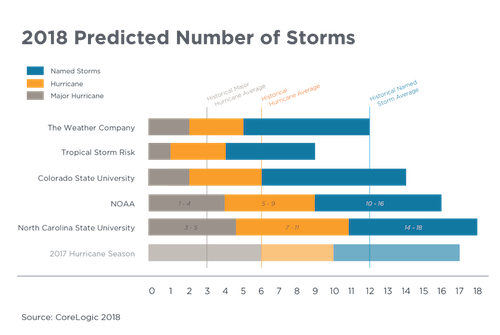
Nearly 7 million homes along the coast are at risk of hurricane storm damage this year, according to the 2018 CoreLogic Storm Surge Report. This could mean a $1.6 trillion potential reconstruction cost.
A storm surge is defined by CoreLogic as a complex phenomenon that occurs when water is pushed toward the shore by powerful winds associated with cyclonic storms and is further influenced by many different factors including, but not limited to, water depth and ocean floor terrain.
The report indicates that weather has a significant impact on properties as well as how insurance coverage is assessed. It analyzed 19 states bordering the Atlantic and Gulf Coasts that are all at risk of storm effects.
This year’s hurricane season is expected to have near-to above-normal activity, as predicted by The National Oceanic and Atmospheric Administration. Of this year’s storm cycle, five of nine storms are likely to evolve into hurricanes while one to four of those will reach Category 3 or higher classifications.
There are more homes along the Atlantic than the Gulf Coast, which is why reconstruction cost value (RCV) is much higher, at north of $1 trillion, compared to the roughly $609 million RCV along the Gulf Coast. If the entire Atlantic coast was faced with a very high risk level storm, a total of 1,438,100 homes would be affected with an RCV of nearly $4 trillion.
Exposure makes the difference
Massachusetts is one of the costal states at lesser risk for storm damage. The coastline and density of development both contribute to its susceptibility. About 157,858 properties in Massachusetts are vulnerable, which is why the estimated statewide-RCV is approximately $46 billion. The RCV here is high, yet it is lower in severity compared to states farther south.
The metro area including Miami, Fort Lauderdale and West Palm Beach have the greatest risk due to more than 788,000 homes with an RCV of $156 billion in the area. New York’s metro area follows just behind with slightly more than 726,000 homes at risk.
Still recovering from 2017
In the wake of Hurricanes Harvey and Irma, areas along the coast are still recovering during the season of storm preparation. After a 12-year storm drought in the United States, 17 named storms swept the coasts in 2017, 10 of which were considered “major” at a level of Category 3 or higher.
The total storm surge losses from Hurricane Harvey came in at just under $1 billion, while Hurricane Irma claimed an estimated $29 to $46 billion in losses, half of which came from counties in Florida.
As the official hurricane season creeps up between June and November, reports suggest the upcoming season will bring an average number of tropical storms and hurricanes. Besides considering the number of storms during storm season, it is much more important to consider the location of landfall for each storm.
“While industry predictions for this year’s storm season indicate average activity levels, associated storm surge risk remains an important consideration for residential and commercial properties in the 19 states analyzed,” said Dr. Tom Jeffery, senior hazard scientist at CoreLogic. “Depending on the location of a storm’s landfall and that area’s population density and reconstruction costs, lower Category storms can cause just as much damage as storms in higher categories.”

